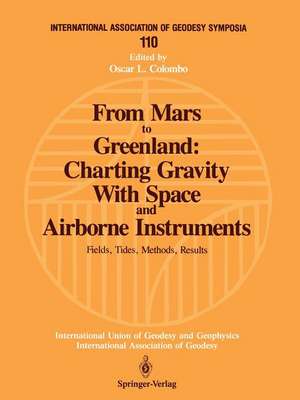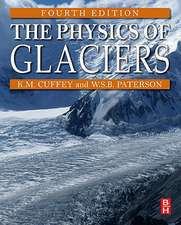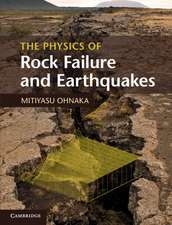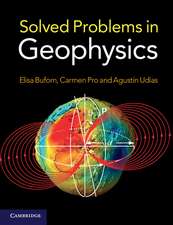From Mars to Greenland: Charting Gravity With Space and Airborne Instruments: Fields, Tides, Methods, Results: International Association of Geodesy Symposia, cartea 110
Editat de Oscar L. Colomboen Limba Engleză Paperback – 23 sep 1992
Din seria International Association of Geodesy Symposia
- 15%
 Preț: 660.49 lei
Preț: 660.49 lei - 18%
 Preț: 956.81 lei
Preț: 956.81 lei - 18%
 Preț: 958.38 lei
Preț: 958.38 lei -
 Preț: 440.22 lei
Preț: 440.22 lei -
 Preț: 430.59 lei
Preț: 430.59 lei -
 Preț: 435.38 lei
Preț: 435.38 lei -
 Preț: 405.28 lei
Preț: 405.28 lei - 15%
 Preț: 662.62 lei
Preț: 662.62 lei - 15%
 Preț: 641.38 lei
Preț: 641.38 lei - 15%
 Preț: 642.03 lei
Preț: 642.03 lei - 15%
 Preț: 640.55 lei
Preț: 640.55 lei - 15%
 Preț: 666.89 lei
Preț: 666.89 lei - 18%
 Preț: 975.29 lei
Preț: 975.29 lei - 15%
 Preț: 661.14 lei
Preț: 661.14 lei - 15%
 Preț: 644.18 lei
Preț: 644.18 lei - 15%
 Preț: 666.24 lei
Preț: 666.24 lei - 15%
 Preț: 679.00 lei
Preț: 679.00 lei - 15%
 Preț: 662.30 lei
Preț: 662.30 lei - 20%
 Preț: 579.46 lei
Preț: 579.46 lei - 20%
 Preț: 566.39 lei
Preț: 566.39 lei - 24%
 Preț: 1640.04 lei
Preț: 1640.04 lei - 18%
 Preț: 1228.62 lei
Preț: 1228.62 lei - 18%
 Preț: 957.62 lei
Preț: 957.62 lei - 20%
 Preț: 571.23 lei
Preț: 571.23 lei - 18%
 Preț: 1221.69 lei
Preț: 1221.69 lei - 18%
 Preț: 1234.94 lei
Preț: 1234.94 lei - 24%
 Preț: 1074.62 lei
Preț: 1074.62 lei - 24%
 Preț: 1633.19 lei
Preț: 1633.19 lei - 24%
 Preț: 1199.25 lei
Preț: 1199.25 lei - 24%
 Preț: 1080.15 lei
Preț: 1080.15 lei - 24%
 Preț: 1549.43 lei
Preț: 1549.43 lei - 18%
 Preț: 1232.89 lei
Preț: 1232.89 lei - 18%
 Preț: 1280.86 lei
Preț: 1280.86 lei - 24%
 Preț: 1069.44 lei
Preț: 1069.44 lei - 18%
 Preț: 1238.56 lei
Preț: 1238.56 lei - 24%
 Preț: 1142.96 lei
Preț: 1142.96 lei
Preț: 655.45 lei
Preț vechi: 771.12 lei
-15% Nou
Puncte Express: 983
Preț estimativ în valută:
125.46€ • 136.32$ • 105.45£
125.46€ • 136.32$ • 105.45£
Carte tipărită la comandă
Livrare economică 21 aprilie-05 mai
Preluare comenzi: 021 569.72.76
Specificații
ISBN-13: 9780387978574
ISBN-10: 0387978577
Pagini: 358
Ilustrații: IX, 358 p. 10 illus.
Dimensiuni: 210 x 280 x 20 mm
Greutate: 0.84 kg
Ediția:1992
Editura: Springer
Colecția Springer
Seria International Association of Geodesy Symposia
Locul publicării:New York, NY, United States
ISBN-10: 0387978577
Pagini: 358
Ilustrații: IX, 358 p. 10 illus.
Dimensiuni: 210 x 280 x 20 mm
Greutate: 0.84 kg
Ediția:1992
Editura: Springer
Colecția Springer
Seria International Association of Geodesy Symposia
Locul publicării:New York, NY, United States
Public țintă
ResearchCuprins
Preface.- Space Techniques I: Long Wavelengths.- Properties of the Gravity Fields of Terrestrial Planets.- Gravity Modeling of Mars and Venus at NASA/GSFC.- An Improved Model of the Earth’s Gravity Field: GEM-T3.- Performance of Recent Gravity Field Models in Precision Orbit Determination Using Doppler Observations.- Gravity Field Estimation From Future Space Missions: Topex/Poseidon, Gravity Probe-B, and Aristoteles.- Integrated Laser Doppler Method for Measuring Planetary Gravity Fields.- Atmospheric Gravitational Influence on Geodetic Satellite Orbits: STARLETTE Analysis.- Observed Temporal Variations in the Earth’s Gravity Field From 16-year STARLETTE Orbit Analysis.- Space Techniques II: High Resolution.- High Resolution Gravity Models Combining Terrestrial and Satellite Data.- Test Results of Analyzing Altimeter Data by a Quasigeostrophic Model of the Sea Surface Topography.- Sea Surface Height Modeling, Generation and Validation of Sample Products.- A Comparison Between Satellite Gravity Data (Geosat) and Marine Gravity Data Measured in the Weddell Sea, Antarctica.- Effect of Water Vapor Corrections for Satellite Altimeter Measurements of the Geoid.- Aristoteles.- Toward a Gradiometer Analytic Model.- A BVP Approach to the Reduction of Spaceborne Gradiometry: Theory and Simulations.- Results From the Simulations of Geopotential Coefficient Estimation From Gravity Gradients.- Laboratory Demonstrations of Superconducting Gravity and Inertial Sensors for Space and Airborne Gravity Measurements.- Airborne Techniques I: New Results.- The Greenland Aerogeophysics Project: Airborne Gravity, Topographic and Magnetic Mapping of an Entire Continent.- Airborne Gravity Measurements Over the Kelvin Seamount.- Airborne Gravity From a Light Aircraft.- Accuracy ofGPS-derived Acceleration From Moving Platform Tests.- Multiple Receiver, Zero-length Baseline Kinematic GPS Positioning Techniques for Airborne Gravity Measurement.- Airborne Techniques II: New Directions.- Airborne Gravimetry, Altimetry, and GPS Navigation Errors.- Requirements for Airborne Vector Gravimetry.- Airborne Vector Gravimetry With an Aided Inertial Survey System.- Controlling Common Mode Stabilization Errors in Airborne Gravity Gradiometry.- GPS/INS Gravity Measurements in Space and on a Balloon.- A BVP Approach to the Reduction of Spaceborne GPS and Accelerometric Observations.- Related Theory.- Walsh-Fourier Series Expansion of the Earth’s Gravitational Potential.- Non-singular Cross-track Derivatives of the Gravitational Potential Using Rotated Spherical Harmonics.- Author Index.














